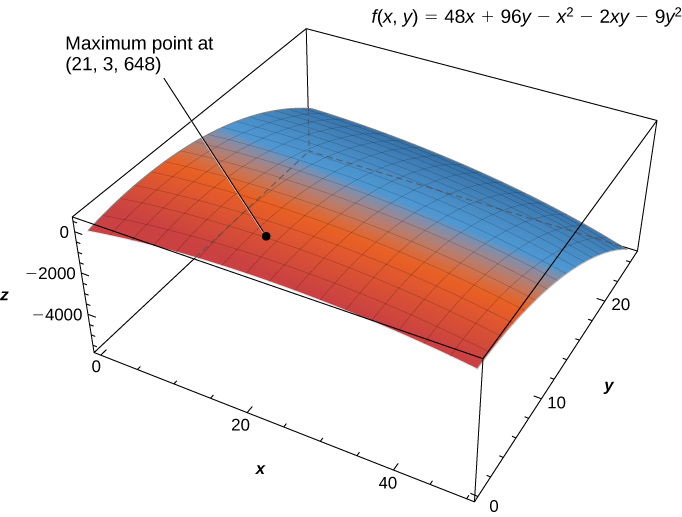Profitable Golf Balls

Figure 1.
Pro-[latex]T[/latex] company has developed a profit model that depends on the number [latex]x[/latex] of golf balls sold per month (measured in thousands), and the number of hours per month of advertising [latex]y[/latex], according to the function
[latex]z=f(x,y)=48x+96y-x^{2}-2xy-9y^{2}[/latex]
where [latex]z[/latex] is measured in thousands of dollars. The maximum number of golf balls that can be produced and sold is [latex]50,000[/latex], and the maximum number of hours of advertising that can be purchased is [latex]25[/latex]. Find the values of [latex]x[/latex] and [latex]y[/latex] that maximize profit, and find the maximum profit.
Solution
Using the problem-solving strategy, step 1 involves finding the critical points of [latex]f[/latex] on its domain. Therefore, we first calculate [latex]f_{x}(x,y)[/latex] and [latex]f_{y}(x,y)[/latex], then set them each equal to zero:
[latex]\begin{array}{c}f_{x}(x,y) &=& 48-2x-2y \hfill \\f_{y}(x,y) &=& 96-2x-18y \hfill \end{array}[/latex]
Setting them equal to zero yields the system of equations
[latex]\begin{array}{c}48-2x-2y &=& 0 \hfill \\96-2x-18y &=& 0 \hfill \end{array}[/latex]
The solution to this system is [latex]x=21[/latex] and [latex]y=3[/latex]. Therefore [latex](21,3)[/latex] is a critical point of [latex]f[/latex]. Calculating [latex]f(21,3)[/latex] gives [latex]f(21,3)=48(21)+96(3)-21^{2}-2(21)(3)-9(3)^{2}=648[/latex].
The domain of this function is [latex]0\le{x}\le{50}[/latex] and [latex]0\le{y}\le{25}[/latex] as shown in the following graph.

Figure 2. Graph of the domain of the function[latex]z=f(x,y)=48x+96y-x^{2}-2xy-9y^{2}[/latex].
[latex]L_{1}[/latex] is the line segment connecting [latex](0,0)[/latex] and [latex](50,0)[/latex], and it can be parameterized by the equations [latex]x(t)=t[/latex], [latex]y(t)=0[/latex] for [latex]0\le{t}\le{50}[/latex]. We then define [latex]g(t)=f(x(t),y(t))[/latex]:
[latex]\begin{array}{c}g(t) &=&f(x(t),y(t)) \hfill \\ &=& f(t,0) \hfill \\ &=& 48t+96(0)-y^{2}-2(t)(0)-9(0)^{2} \hfill \\ &=& 48t-t^{2} \hfill \end{array}[/latex]
Setting [latex]g^{\prime}(t)=0[/latex] yields the critical point [latex]t=24[/latex], which corresponds to the point [latex](24,0)[/latex] in the domain of [latex]f[/latex]. Calculating [latex]f(24,0)[/latex] gives [latex]576[/latex].
[latex]L_{2}[/latex] is the line segment connecting [latex](50,0)[/latex] and [latex](50,25)[/latex], and it can be parameterized by the equations [latex]x(t)=50[/latex], [latex]y(t)=t[/latex] for [latex]0\le{t}\le{25}[/latex]. Once again we define [latex]g(t)=f(x(t),y(t))[/latex]:
[latex]\begin{array}{c}g(t) &=&f(x(t),y(t)) \hfill \\ &=& f(50,t) \hfill \\ &=& 48(50)+96t-50^{2}-2(50)t-9t^{2} \hfill \\ &=& -9t^{2}-4t-100 \hfill \end{array}[/latex]
This function has a critical point [latex]t=-\frac{2}{9}[/latex], which corresponds to the point [latex](50,-\frac{2}{9})[/latex]. This point is not in the domain of [latex]f[/latex].
[latex]L_{3}[/latex] is the line segment connecting [latex](0,25)[/latex] and [latex](50,25)[/latex], and it can be parameterized by the equations [latex]x(t)=t[/latex], [latex]y(t)=25[/latex] for [latex]0\le{t}\le{50}[/latex]. We define [latex]g(t)=f(x(t),y(t))[/latex]:
[latex]\begin{array}{c}g(t) &=&f(x(t),y(t)) \hfill \\ &=& f(t,25) \hfill \\ &=& 48(t)+96(25)-t^{2}-2t(25)-9(25)^{2} \hfill \\ &=& -t^{2}-2t-3225 \hfill \end{array}[/latex]
This function has a critical point [latex]t=-1[/latex], which corresponds to the point [latex](-1,25)[/latex], which is not in the domain.
[latex]L_{4}[/latex] is the line segment connecting [latex](0)[/latex] and [latex](0,25)[/latex], and it can be parameterized by the equations [latex]x(t)=0[/latex], [latex]y(t)=t[/latex] for [latex]0\le{t}\le{25}[/latex]. We define [latex]g(t)=f(x(t),y(t))[/latex]:
[latex]\begin{array}{c}g(t) &=&f(x(t),y(t)) \hfill \\ &=& f(0,t) \hfill \\ &=& 48(0)+96t-(0)^{2}-2(0)t-9t^{2} \hfill \\ &=& 96t-t^{2} \hfill \end{array}[/latex]
This function has a critical point [latex]t=\frac{16}{3}[/latex], which corresponds to the point [latex](0,\frac{16}{3})[/latex], which is on the boundary of the domain. Calculating [latex]f(0,\frac{16}{3})[/latex] gives [latex]256[/latex].
We also need to find the values of [latex]f(x,y)[/latex] at the corners of its domain. These corners are located at [latex](0,0),(50,0),(50,25),\text{ and }(0,25)[/latex]:
[latex]\begin{array}{c}f(0,0) &=& 48(0)+96(0)-(0)^{2}-2(0)(0)-9(0)^{2}=0 \hfill \\f(50,0) &=& 48(50)+96(0)-(50)^{2}-2(50)(0)-9(0)^{2}=-100 \hfill \\f(50,25) &=& 48(50)+96(25)-(500)^{2}-2(50)(25)-9(25)^{2}=-5825 \hfill \\f(0,25) &=& 48(0)+96(25)-(0)^{2}-2(0)(25)-9(25)^{2}=-3225 \hfill \end{array}[/latex]
The maximum critical value is [latex]648[/latex] which occurs at [latex](21,3)[/latex]. Therefore, a maximum profit of [latex]\$648,000[/latex] is realized when [latex]21,000[/latex] golf balls are sold and [latex]33[/latex] hours of advertising are purchased per month as shown in the following figure.

Figure 3. The profit function [latex]f(x,y)[/latex] has a maximum at [latex](21,3,648)[/latex].
Candela Citations
- Calculus Volume 3. Authored by: Gilbert Strang, Edwin (Jed) Herman. Provided by: OpenStax. Located at: https://openstax.org/books/calculus-volume-3/pages/1-introduction. License: CC BY-NC-SA: Attribution-NonCommercial-ShareAlike. License Terms: Access for free at https://openstax.org/books/calculus-volume-3/pages/1-introduction
